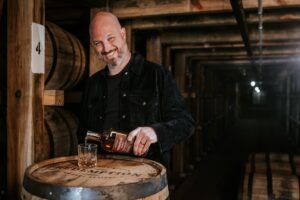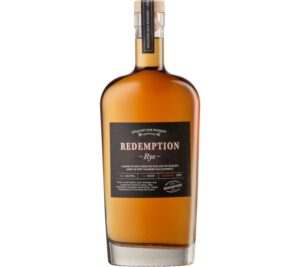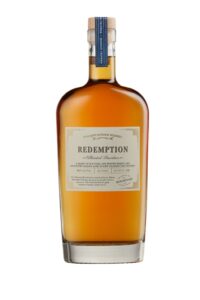By Richard Thomas
Among the most prominent of the sourced whiskey brands is Redemption, which is particularly well known for its Redemption Rye expressions. As part of Deutsch Family Spirits, Redemption has greatly expanded its line-up over time, embracing various types of bourbon and even putting out a couple of ultra-aged whiskeys.
Sourced whiskeys are routinely underestimated by snobby dilettantes, who fail to understand what goes into making them. In their imagination, a sourced brand merely acquires the barrels and sends them straight to the bottling plant. The reality couldn’t be further from the truth, and the blending work that goes into a sourced brand is basically the same as what goes on at any distillery.
At Redemption, the blending duties are in the hands of Alan Kennedy, who replaced Dave Carpenter in Summer 2023 (Carpenter went back to Jeptha Creed, where he had previously been the Head Distiller and is now Master Distiller). At The Whiskey Reviewer, we always prefer to catch up a new person occupying the top whiskey-making slot at least several months after they take the job, reckoning that they’ll have more to say about it by then. That made now that time to reach out to Kennedy and check in on Redemption Whiskey.
I’ve heard you were a pastry chef and sommelier at one time, and I can see that you were doing a lot of brand ambassador work about a decade ago. How did that prepare you for coming over to the production side of things when you went to work for Alltech/Lexington Brewing & Distilling?
My background as a pastry chef, sommelier and brand ambassador, as well as my current role as Master Blender are all connected by my love for creativity. The world of food and beverages is so powerful, it connects people and brings so much feeling to an experience.
As a sommelier, I craved more freedom to experiment and innovate, which led me to consult with a number of spirits brands on everything from the liquid to the marketing approach. Through this, I was able to meet and eventually learn from many different inspirational distillers and blenders before eventually becoming one of the youngest up-and-coming Master Blenders on the Kentucky Bourbon Trail at the time.
Speaking of which, there is this whole thing in American Whiskey for baking bread as a way of doing a pilot project for a whiskey mash. Coming at that notion with your pastry background, do you see the utility? I know it leaves a lot of people who come at it from an Irish or Scottish perspective scratching their heads.
There is an unmistakable connection between grain and whiskey – it’s what whiskey is made from. The utility in baking bread is a foundational skill for distilling whiskey because it’s a great way to understand the complexities of the grain, from its taste to its reactivity.
While I have not personally tried baking bread as a pilot for whiskey mash, I see the value in it because the percentages of grain in American Whiskey can be very close in a mashbill. For example, we might be using 51% corn and 45% wheat so tasting the balance of the sweetness to roundness beforehand could be helpful.
How did you get tapped to take over as Master Blender at Redemption, which is one of the biggest of the sourced rye whiskey brands around?
Starting my career as a pastry chef turned sommelier, I’m fortunate to have met and learned from many inspirational experts who led me to where I am today. Throughout my career, my mentors have challenged, championed, and supported me to forge my own path as a Master Blender, which led me to Redemption.
I’ve always been a fan of Redemption, but was really drawn to the brand when they released Sur Lee Straight Rye Whiskey, a first-of-its-kind whiskey inspired by the French sur lie winemaking process. It changed my view on the possibilities of what rye whiskey could be. Now, I have the pleasure of working with other Deutch Family winemakers and distillers, like Wayne Donaldson, who has taught me new winemaking techniques that I’m excited to try in the whiskey world.
As a brand rooted in a combination of tradition through its mission of restoring rye whiskeys to pre-Prohibition standards and modern innovation, I’m thrilled to be a part of Redemption’s storied history and to lead the charge on experimentation and innovation.
What are the differences between being Master Blender at Town Branch, which is a brewstillery, and at the all-sourced Redemption?
The greatest difference is the library of options now at my fingertips. At Redemption, I have the ability to paint with a great spectrum of mashbills and ages, and in larger batches. This allows me to nuance my blends and add a creative dimension to my work that I’ve never had before. I’m forever grateful to have learned from Brandon Martin and the brewers at Town Branch, which has been invaluable to my growth and understanding of flavor development. The passion and the beauty that a brewer can bring to whiskey is often overlooked, and I’m enjoying the ability to blend using my unique perspectives as a brewer and a whiskey blender.
Now that you’ve been at Redemption for more than six months, what was the biggest surprise you had waiting for you in the transition?
I never could have anticipated the deep sense of satisfaction that I get as Redemption’s Master Blender.
Some people think that a Master Blender’s main role is to taste the final product. While this step is crucial, and delicious, my role as Master Blender starts long before our whiskey is made and continues far beyond the final product. This role has allowed me to be creative and innovative in more ways than I ever imagined, and I look forward to continuing to reach new whiskey lovers and attract whiskey novices with not only new blends, but our classic offerings as well.
I’ve read you named Dave Pickerell, the late Johnny Appleseed of craft whiskey, as a mentor. What is your connection with Pickerell?
Dave Pickerell was one of my biggest mentors, and I feel fortunate to have learned as much as I did under his guidance. He taught me the unique traditions of American Whiskey, and it’s because of him that my love for whiskey, not only as a personal passion, but as a career, developed.
During my time in the bartending world, Dave and I worked side-by-side at industry events. Years later, I had the opportunity to work even closer with him at Whistlepig. One of my fondest memories with Dave is being able to travel the American South with him while working with Whistlepig. I got to ask questions, hear stories, and greatest of all, we developed a genuine friendship. Learning firsthand alongside him during the creation of new whiskies and brand expansion provided me with invaluable experience. Whether in the distillery or over a shared meal, I was able to observe and absorb his expertise while gaining tremendous industry experience.
I think a lot of casual drinkers in America don’t understand the difference between distilling a new make and actually crafting a batch for bottling, assuming the latter just comes together on its own. So, can you describe your process for ensuring consistency on an existing product? And also for creating a new one?
The process of crafting a new whiskey is long and complicated, but also yields beautiful results. With so many opportunities to add creativity to a new batch, it is important to pay close attention to each step to ensure consistency. We monitor all technical elements of the distilling process, from the temperature and light of the room to the lifespan of the barrel. It is all about achieving the perfect balance of consistency and spontaneity.
While the technical aspects of blending are extremely important, I also let my memory lead my approach in order to create whiskeys that draw out fond memories or specific feelings – whiskeys that have “soul,” as I like to say.
Before blending, I sit down and take in the world around me. It’s important to make time to feel a moment in every sense and in every way in order to find inspiration for blending. And, for me, inspiration can strike at any minute. Like last Halloween, when I took my daughter trick-or-treating, and at one point the walk became too much. We sat down together to pass out candy while my wife and our other daughter continued on. While passing out candy, my daughter came across a bag of old school caramel and coated Sugar Daddy candies. When she took a bite, I watched the expression on her face and was just amazed by her experience. This type of deep satisfaction, mixed with surprise and pure joy, is the type of feeling I want to bring to life when blending a new batch.
 The Whiskey Reviewer A World of Whiskey, Poured Every Weekday
The Whiskey Reviewer A World of Whiskey, Poured Every Weekday




